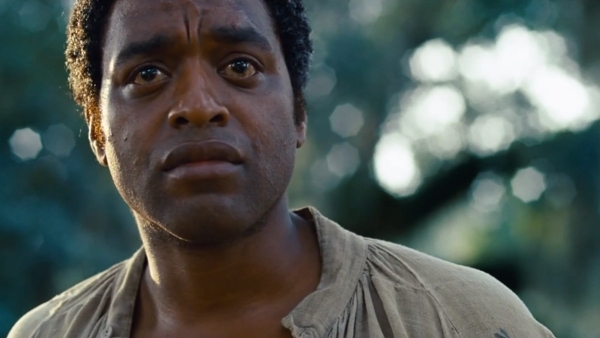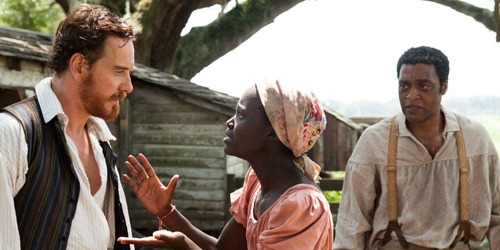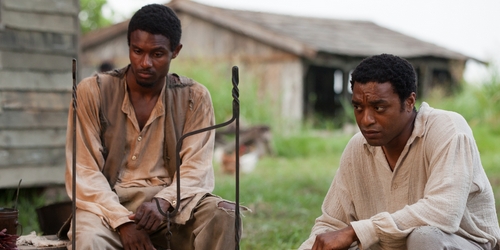 From behind the iron-barred basement windows of a faceless tenement building nestled alongside so many others that look just like it, a man frantically cries out for aid. His words echo fruitlessly, bouncing between alleyways and sidewalks as they’re smothered by the brick facade of the structures surrounding him; his pleas goes unanswered, leaving him utterly trapped, robbed of his freedom and with no means of alerting his family or his friends – hours away in Saratoga – of his plight. But he continues to make appeals to the deserted street, and as he does, the camera pans up, revealing that this heartbreaking display of hopelessness and isolation is unfolding smack-dab in the hadosw of the United States’ Capitol. Land of the free, indeed.
From behind the iron-barred basement windows of a faceless tenement building nestled alongside so many others that look just like it, a man frantically cries out for aid. His words echo fruitlessly, bouncing between alleyways and sidewalks as they’re smothered by the brick facade of the structures surrounding him; his pleas goes unanswered, leaving him utterly trapped, robbed of his freedom and with no means of alerting his family or his friends – hours away in Saratoga – of his plight. But he continues to make appeals to the deserted street, and as he does, the camera pans up, revealing that this heartbreaking display of hopelessness and isolation is unfolding smack-dab in the hadosw of the United States’ Capitol. Land of the free, indeed.
It’s one of the most provocative sequences in Steve McQueen’s landmark film, 12 Years a Slave, even when compared to its graphic scenes of interracial abuse and physical, psychological cruelties. Here, McQueen makes his best effort to contextualize an atrocity in our country’s past within a more current framework; the visual cue reminds us that even a century and a half after slavery’s abolition, America still remains guilty and convicted of institutionalizing human debasement. That’s entirely McQueen’s aim, of course – not to sugarcoat America’s antebellum history, as so many other movies covering the topic do, but to paint as frank and unforgiving a portrait of an era when its leaders passed laws that categorized black people as property.
Here, McQueen puts his focus on Solomon Northup, a free-born black man who – after accepting a job playing the fiddle in a traveling circus and making the trip to D.C. – was duped, drugged, and spirited away to New Orleans in 1841. He was sold a Louisiana slaver and dehumanized for over a decade before regaining the freedom granted him at birth. His memoirs, penned in the year of his release, serve as the foundation for 12 Years a Slave‘s narrative, detailing the stretch of his life he spent laboring under the heels of white bigotry; he died in 1857, only four years after making it home to his family. Mercifully, McQueen elects to end the film before arriving at that inevitable conclusion, but even the final cathartic note he ends on does little to assuage him of his spiritual anguish. He’s a man changed from the one we get to know in brief flashbacks scattered throughout 12 Years a Slave‘s running time.
The film possesses an undeniably American identity; it takes place largely in southern locations (including actual historic plantations), it documents one of the most shameful transgressions of the United States’ past, and it unflinchingly depicts the endless barbarisms inflicted upon a very real American man by our (now thankfully bygone) slave culture, among many others. The senses of period and place that McQueen effortlessly evokes here has provided a focal point for much of the critical response 12 Years a Slave has received; very few American pictures that deal with the politics and inherent trauma of slavery do so with a level of integrity that’s either this steadfast or this explicit, focusing on white characters as saviors while treating black characters almost as secondary.

Yet if 12 Years a Slave confronts slavery from a place of cultural specificity, the individual experience it details happens to be one that’s global rather than strictly national. Slavery finds its very roots in the act of abduction, dating back to the beginning of the Atlantic slave trade; those forced into servitude were either prisoners of endemic warfare, sold by African elites to European settlers, who in turn transported them to all the corners of the New World, or kidnapping victims. Only around roughly six and a half percent of all distributed slaves made their way to North America, where over time the slave mantle came to be treated as hereditary; most slaves were born as unwilling participants into systemic oppression, inheriting their parents’ social status by law.
By contrast, Solomon’s father passed down the gift of manumission to him. He grew up free in the northern US, only coming to know the horror of slavery at thirty three years old. His personal struggle, then, more closely resembles those suffered by native Africans than by black men, women, and children bred into slavery on American soil: purloined from his home, taken to a strange land, and made to toil against his will under the threat of pain. Solomon certainly wasn’t the only freeman of his day to be targeted in a hijacking plot – the practice became more commonplace as demand rose for slave laborers on southern cotton plants – but he, and those who shared the same fate as him, were the minority in comparison to people for whom enslavement was their birthright.
Of course, America long since has overcome (though perhaps not totally reconciled) its legacy as a country built by slave labor. However, the old tricks of the trade remain in use in other parts of the world where modern slavery runs rampant; for all the years that have passed, the methodology hasn’t changed much. Slavers still frequently employ the ruse of persuasion, using the promise of work and wages to lure in targets who ultimately disappear and are never heard from again; that scheme should, by now, sound sickeningly familiar. There are other scams and cons run by experienced traffickers, mind, but the tantalizing offer of a better life may rank as the most powerful and effective among them.
Given slavery’s point of origin, it may come as little surprise that Mauritania – located in northwestern Africa – boasts one of the highest concentrations of slave labor across the entire planet, or that Africa in general is rife with slavery in all its contemporary forms. One barely needs to glance at the 2013 Global Slavery Index for proof, or to discover that only Pakistan, Haiti, Nepal, India, and Moldova match Mauritania in terms of slavery’s sheer estimated prevalence. Call it bonded labor, forced labor, child slavery, descent-based slavery, trafficking (sexual or human), or any other label you like; no one can deny the continued existence of slavery, which lets us examine the events of 12 Years a Slave from a decidedly modern perspective, connecting micro-level torment to the macro-scale human rights violations that still transpire today.

No one may immediately think of Solmon Northup as a lucky man; he had a quarter of his life stolen from him by the slave establishment, and died a mere four years after returning to his family. But as McQueen reminds us in the film’s coda, Northup was one of the few people who fell prey to the Reverse Underground Railroad and managed to make it back home to tell the tale. The number of black slaves who died in their bonds – whether they came from the same background as Solomon or not – is beyond count. Admittedly, that’s a pretty grotesque silver lining, but it’s a silver lining nonetheless – and one that the nearly thirty million enslaved men, women, and children on Earth would probably give anything for.
Tragically, brand of injustice Solomon endured for so long persists to this very day, and that alone grants 12 Years a Slave a sense of relevancy and urgency. Yes, the film gives us the opportunity to confront a significant historical moment in our society’s lifespan; yes, it recreates the anguish felt by one specific man caught in the gears of the slavery machine. But whether McQueen intended to or not, his work indirectly calls to mind the sort of lies and the exploitation that continue to manufacture too many present-day Solomon Northups. Solomon may have told his story a hundred and sixty years ago, but it’s not finished just yet.



